![]()
![]()
![]()
Use LEFT and RIGHT arrow keys to navigate between flashcards;
Use UP and DOWN arrow keys to flip the card;
H to show hint;
A reads text to speech;
45 Cards in this Set
- Front
- Back
|
What is consumer behaviour?
|
The totality of consumers' decisions with respect to the acquisition, consumption and disposition of goods, services, time and ideas by human decision-making units over time.
|
|
|
Absolute Threshold
|
The minimum amount of stimuli able to be detected by an individual
|
|
|
Differential Threshold
|
The ability to detect changes between two different stimuli
|
|
|
Weber's Law
|
The greater the initial stimulus, the greater the degree of change necessary for it to be noticed
|
|
|
Schema
|
A set of beliefs
|
|
|
Maslow's Hierarchy of Needs
|
Physiological: "Nurofen goes straight to the source of pain"
Safety: Lloyd's Life Insurance "cash if you die cash if you don't" Love/Belonging: Nokia "Connecting People" Esteem/Ego: Jaguar "370 horse power leaves people no choice but to talk behind your back" Self-Actualisation: Adidas "Impossible is Nothing" |
|
|
Social vs Non-Social Needs
|
Social: Externally directed and relate to other individuals - need for status, support, love
Nonsocial: achievement not based on other people - need for sleep, control, variety, novelty |
|
|
Functional needs
|
Motivate search for offerings that solve consumption related problems
Social functional needs: modeling, support (hiring a nanny) Nonsocial: order, safety (buying a car with air bags) |
|
|
Symbolic needs
|
Relate to how we perceive ourselves, are perceived by others, how we relate to others
Social: achievement, belonging, status, need to avoid rejection Nonsocial: self-control, independence |
|
|
Hedonic needs
|
Relate to sensory pleasure - good taste, luxury brands, perfume, pretty things
Social: sex, play Nonsocial: sensory stimulation, cognitive stimulation, novelty |
|
|
Characteristics of needs
|
Never fully satisfied
Exist in hierarchy Can conflict: approach-approach (ie. burger vs burrito), approach-avoidance (ie. weight loss vs ice-cream), avoidance-avoidance (ie. medicine vs hospital) |
|
|
Mehrabian-Russell model (PAD)
|
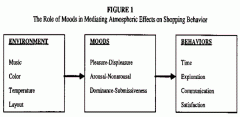
Pleasure: degree to which a person feels good, happy, satisfied
Arousal: feelings of excitement, stimulation or feelings of boredom Dominance: the extent to which an individual feels in control Physical: desire to stay in or avoid store Exploratory: willingness to explore or avoid Communication: willingness to talk to sales personnel or ignore them Satisfaction: degree of enhancement or hindrance of satisfaction |
|
|
Semiotics
|
Correspondence between signs and symbols and their role in the assignment of meaning
|
|
|
Classical Conditioning
|
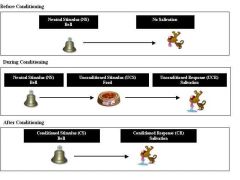
Product placement - we associate products with positive emotions due to film
Social marketing - associate disgust with smoking |
|
|
Instrumental/Operant Conditioning
|
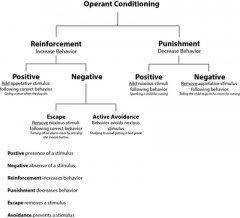
We learn to perform behaviours with positive outcomes and avoid those with negative outcomes
Made deliberately to obtain a goal May happen over a period of time as a shaping process |
|
|
Observational Learning
|
Learning occurs when new knowledge is acquired or existing knowledge is modified by experience
|
|
|
Dimensions of attitudes
|
Valence
Strength/Intensity Certainty/Confidence Accessibility/Salience Complexity/Ambivalence Commitment/Persistence/Resistence |
|
|
Dual Mediation Hypothesis
|
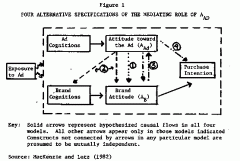
|
|
|
ELM
|
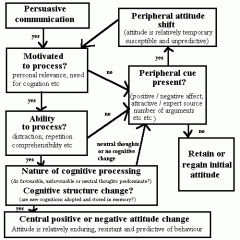
Framework for organising, categorising and understanding the basic processes underlying the effectiveness of persuasive communications.
|
|
|
Central Route processing
|
The attitude formation and change process when effort is high.
|
|
|
Peripheral Route processing
|
The attitude formation and change process when effort is low.
|
|
|
Peripheral Cues
|
Music, celebrity endorsements, visuals - feature providing information in absence of effortful thinking
|
|
|
SCREM
|
Source - attractiveness, trustworthiness, expertise
Channel - passive vs active consumer engagement Receiver - mood, personal relevance Environment - distraction, repetition of message Message - quality of arguments, number of arguments, message length |
|
|
Steps in the Decision Making Process
|
Problem Recognition
Information Search Options Assessment/Judgement Purchase Decision Post-Purchase Evaluation Feedback |
|
|
A model of Habitual Purchasing Behaviour
|
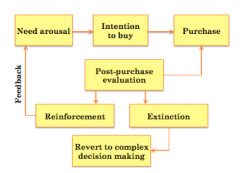
|
|
|
Complex Decision Making
|
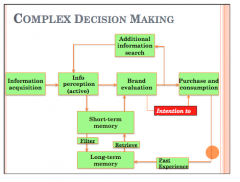
|
|
|
dual-mediation hypothesis
|
Explains how attitudes toward the ad influence brand attitudes.
|
|
|
Limitations of Maslow
|
Physiological - appetite for certain foods
Intensity of needs are culture bound Motivations arent always driven by personal needs, rather by societal needs - ie. ethical consumption Unconscious motives lead to unconscious desires - ie. smell of food leads to hunger Hidden motives - desires might be surface indicators of more basic needs - ie. desire for icecream indirect expression of need for love |
|
|
Cognitive dissonance
|
Tendency to focus on the bad aspects of a chosen products and lose out on good qualities of not chosen one
|
|
|
approach-avoidance conflict
|
A conflict that occurs when a given behaviour or outcome is seen as both desirable and undesirable because it satisfies some needs but fails to satisfy others.
|
|
|
avoidance-avoidance conflict
|
A conflict that occurs when the consumer must choose between two equally undesirable options.
|
|
|
Perceived risk
|
The extent to which the consumer is uncertain about the consequences of an action e.g., buying, using, or disposing of an offering.
|
|
|
personal relevance
|
Something that has a direct bearing on the self and has potentially significant consequences or implications for our lives.
|
|
|
Describe consumer characteristics that may affect retrieval of product information.
|
An expert consumer is more likely to have highly elaborated semantic networks concerning products than an average consumer has. Because her networks include many categories containing many products, as well as detailed information about each product, an expert is far more likely than an average consumer to retrieve information about products. Also, a consumer is more likely to retrieve product information when she is in a positive, upbeat mood, or when the product information matches her mood.
|
|
|
Ambivalence
|
When our evaluations regarding a brand are mixed (both positive and negative).
|
|
|
attitude toward the act (Aact)
|
How we feel about doing something.
|
|
|
attitude toward the ad (Aad)
|
Whether the consumer likes or dislikes an ad.
|
|
|
Behaviour (B)
|
What we do.
|
|
|
behavioral intention (BI)
|
What we intend to do.
|
|
|
Antecedents of motivation to process information
|
Involvement (personal relevance)
Personal responsibility for processing the message Need for cognition |
|
|
Antecedents of ability to process information
|
Consumer knowledge
Amount of distraction Repetition of message |
|
|
episodic memory
|
Knowledge we have about ourselves and our personal experiences.
|
|
|
consumer memory
|
A personal storehouse of knowledge about products and services, shopping, and consumption experiences.
|
|
|
semantic memory
|
Knowledge about an entity that is detached from specific episodes - facts.
|
|
|
confirmation bias
|
Tendency to recall information that reinforces or confirms our overall beliefs rather than contradicting them, thereby making our judgment or decision more positive than it should be.
|

